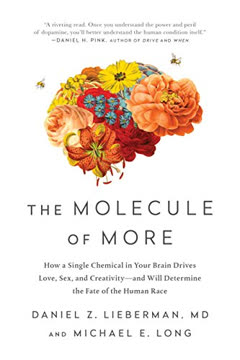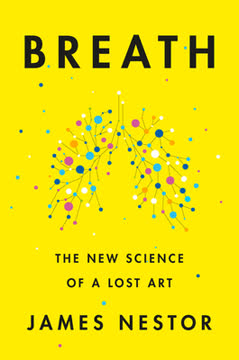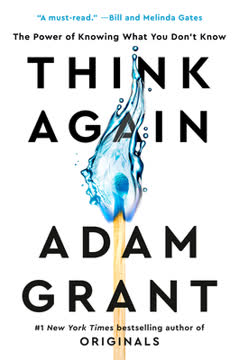Key Takeaways
1. The Dopamine Overload: Our World of Excessive Pleasure
The smartphone is the modern-day hypodermic needle, delivering digital dopamine 24/7 for a wired generation.
Our dopamine-flooded world. We live in an era of unprecedented abundance, where high-reward stimuli are constantly at our fingertips. From social media and streaming services to fast food and online shopping, we're surrounded by sources of instant gratification. This constant exposure to dopamine-triggering activities has fundamentally altered our relationship with pleasure and pain.
The cost of constant pleasure. While this abundance may seem like a dream come true, it comes with significant drawbacks:
- Increased rates of addiction across various substances and behaviors
- Rising levels of anxiety, depression, and chronic pain
- Decreased ability to find joy in simple pleasures
- Difficulty delaying gratification and focusing on long-term goals
The challenge we face is learning to navigate this dopamine-rich environment without losing ourselves to compulsive overconsumption.
2. Understanding the Pleasure-Pain Balance in Our Brains
Scientists rely on dopamine as a kind of universal currency for measuring the addictive potential of any experience. The more dopamine in the brain's reward pathway, the more addictive the experience.
The brain's balancing act. Our brains process pleasure and pain in the same regions, functioning like a balance. When we experience pleasure, dopamine is released, tipping the balance to one side. However, the brain seeks equilibrium and quickly works to level things out, often overshooting and leaving us in a state of mild pain or craving.
Key aspects of this balance:
- Tolerance: With repeated exposure, we need more of a stimulus to achieve the same level of pleasure
- Withdrawal: The pain or discomfort experienced when a pleasurable stimulus is removed
- Neuroadaptation: Long-term changes in brain structure and function due to repeated exposure
Understanding this balance is crucial for recognizing why we struggle with addictive behaviors and how we can work to restore equilibrium.
3. Self-Binding: Creating Barriers to Limit Compulsive Behavior
Self-binding openly recognizes the limitations of will.
Proactive prevention. Self-binding involves intentionally creating obstacles between ourselves and our addictive behaviors. This strategy acknowledges that willpower alone is often insufficient to combat compulsive urges, especially in moments of weakness.
Types of self-binding:
- Physical: Removing temptations from our environment (e.g., deleting social media apps)
- Temporal: Setting specific time limits for certain activities
- Categorical: Avoiding entire classes of behaviors or substances
Examples of self-binding:
- Using website blockers to limit access to distracting sites
- Keeping junk food out of the house
- Setting up automatic savings transfers to prevent overspending
By implementing these barriers, we can make it easier to resist temptation and maintain healthier habits.
4. The Dopamine Fast: Resetting Our Reward Pathways
Abstinence resets the brain's reward pathway and with it our capacity to take joy in simpler pleasures.
The power of abstinence. A dopamine fast involves temporarily abstaining from highly stimulating activities to restore balance to our reward systems. This practice can help us break addictive cycles and rediscover the joy in everyday experiences.
Key components of a successful dopamine fast:
- Duration: Typically 4 weeks for optimal results
- Comprehensiveness: Avoiding all high-dopamine triggers
- Mindfulness: Observing our thoughts and feelings during the process
- Support: Seeking help from friends, family, or professionals
Benefits of dopamine fasting:
- Increased sensitivity to natural rewards
- Improved focus and productivity
- Reduced anxiety and compulsive behaviors
- Greater appreciation for simple pleasures
While challenging, a dopamine fast can be a powerful tool for resetting our relationship with pleasure and pain.
5. Embracing Pain: A Counterintuitive Path to Well-Being
Pain leads to pleasure by triggering the body's own regulating homeostatic mechanisms.
The benefits of discomfort. Contrary to our instincts, intentionally seeking out certain forms of pain or discomfort can lead to improved well-being. This concept, known as hormesis, involves exposing ourselves to moderate stress to build resilience and stimulate positive adaptations.
Examples of beneficial stressors:
- Cold exposure (e.g., ice baths, cold showers)
- Intense exercise
- Intermittent fasting
- Challenging mental tasks
By engaging with these controlled forms of stress, we can:
- Boost our mood and energy levels
- Improve physical health and longevity
- Increase mental resilience and focus
- Reduce our reliance on artificial stimuli for pleasure
The key is finding the right balance – enough stress to stimulate growth, but not so much that it becomes overwhelming or harmful.
6. Radical Honesty: The Power of Truth-Telling in Recovery
Telling the truth draws people in, especially when we're willing to expose our own vulnerabilities.
The transformative impact of honesty. Practicing radical honesty – being truthful in all aspects of life, even when it's uncomfortable – can be a powerful tool for personal growth and recovery from addictive behaviors.
Benefits of radical honesty:
- Increased self-awareness
- Stronger, more authentic relationships
- Reduced cognitive load from maintaining lies
- Greater accountability for our actions
Implementing radical honesty:
- Start with small truths and build up to bigger ones
- Practice self-compassion when revealing difficult truths
- Seek support from trusted individuals or groups
- Use honesty as a way to connect with others, not to hurt them
By embracing radical honesty, we can create a foundation for lasting change and deeper connections with ourselves and others.
7. Prosocial Shame: Leveraging Accountability for Positive Change
Prosocial shame affirms that we belong to the human tribe.
Harnessing shame productively. While shame is often seen as purely negative, prosocial shame can be a powerful motivator for positive change. This involves acknowledging our mistakes within a supportive community that offers clear paths for redemption and growth.
Key elements of prosocial shame:
- Accountability without rejection
- Clear guidelines for making amends
- Emphasis on personal growth and learning
- Support from a community of peers
Examples of prosocial shame in action:
- 12-step programs like Alcoholics Anonymous
- Restorative justice practices
- Family or community interventions
By reframing shame as a tool for growth rather than punishment, we can create environments that promote lasting behavioral change and strengthen social bonds.
8. Finding Balance in a Dopamine-Saturated World
Instead of running away from the world, we can find escape by immersing ourselves in it.
Cultivating sustainable joy. The ultimate goal is to find balance in our dopamine-rich environment, allowing us to enjoy life's pleasures without falling into compulsive overconsumption.
Strategies for maintaining balance:
- Practice mindfulness and present-moment awareness
- Engage in activities that provide natural, sustainable rewards
- Cultivate meaningful relationships and social connections
- Set clear boundaries around potentially addictive behaviors
- Regularly reassess and adjust our relationship with technology and other stimuli
By implementing these practices, we can navigate our dopamine-saturated world more skillfully, finding joy in both life's simple pleasures and its more intense experiences without losing ourselves in the process.
Last updated:
FAQ
What's Dopamine Nation about?
- Exploration of Pleasure and Pain: Dopamine Nation by Anna Lembke explores the complex relationship between pleasure and pain, highlighting how this balance is crucial for a fulfilling life.
- Neuroscience of Addiction: The book delves into the role of dopamine as a key player in addiction, explaining how it acts as a "universal currency" for measuring the addictive potential of experiences.
- Personal Stories and Insights: Lembke enriches the narrative with real-life stories from her patients, illustrating their struggles with addiction and recovery, making the scientific concepts more relatable.
Why should I read Dopamine Nation?
- Understanding Modern Challenges: The book provides insights into the compulsive overconsumption prevalent in today's society, helping readers recognize their own behaviors and the underlying neuroscience.
- Practical Solutions Offered: Lembke offers practical advice on managing compulsive behaviors, including "dopamine fasting" and self-binding strategies, to help regain control over consumption habits.
- Empathy and Connection: Through patient stories, Lembke fosters empathy and understanding for those struggling with addiction, encouraging readers to reflect on their own lives and relationships.
What are the key takeaways of Dopamine Nation?
- Pleasure-Pain Balance: The book emphasizes maintaining a balance between pleasure and pain, as excessive pleasure can lead to addiction and increased pain sensitivity.
- Dopamine Fasting: Lembke introduces "dopamine fasting" to reset the brain's reward system, helping individuals enjoy simple pleasures again.
- Self-Binding Strategies: The author discusses self-binding as a method to create barriers between oneself and addictive behaviors, using physical, chronological, and categorical techniques.
What is dopamine, and why is it important in Dopamine Nation?
- Dopamine as a Neurotransmitter: Dopamine plays a crucial role in the brain's reward system, influencing motivation and pleasure, and is released during pleasurable activities.
- Addiction Measurement: The more dopamine a behavior or substance releases, the more addictive it becomes, making dopamine a key factor in understanding addiction.
- Impact on Balance: Excessive dopamine release can tip the pleasure-pain balance, leading to a cycle of addiction and increased pain sensitivity.
What is dopamine fasting, and how does it work in Dopamine Nation?
- Definition of Dopamine Fasting: It involves abstaining from high-dopamine activities to reset the brain's reward system, such as avoiding social media and junk food.
- Benefits of the Practice: This practice helps individuals regain sensitivity to pleasure and appreciate simpler experiences, with many reporting improved well-being after abstinence.
- Implementation: Lembke suggests starting with a month-long dopamine fast to observe changes in mood and cravings, allowing the brain to recalibrate.
What are self-binding strategies mentioned in Dopamine Nation?
- Creating Barriers: Self-binding involves creating barriers between oneself and addictive behaviors to reduce relapse likelihood, such as removing temptations.
- Chronological and Categorical Binding: Lembke categorizes self-binding into physical, chronological, and categorical types, helping manage consumption by limiting access or defining acceptable behaviors.
- Real-Life Examples: The book provides examples of patients successfully implementing self-binding strategies, empowering individuals to control their behaviors.
How does Dopamine Nation address the societal impact of addiction?
- Cultural Commentary: Lembke critiques society's obsession with pleasure and the resulting rise in addiction rates, highlighting the abundance of high-dopamine stimuli.
- Economic Factors: The book discusses how socioeconomic status influences access to addictive substances and the prevalence of addiction, noting disparities among demographic groups.
- Call to Action: Lembke encourages reflection on personal consumption habits and societal structures enabling addiction, advocating for a compassionate understanding of addiction as a public health issue.
How does Dopamine Nation address the role of technology in addiction?
- Technology as a Trigger: Lembke discusses how technology, especially social media and gaming, can trigger addictive behaviors due to constant availability of pleasurable stimuli.
- Dopamine Overload: Technology can create a dopamine overload, making it difficult to find joy in simpler activities, leading to a cycle of seeking more intense experiences.
- Strategies for Moderation: Lembke offers strategies like setting boundaries and engaging in dopamine fasting to manage technology use and reduce addiction risk.
What is the pleasure-pain balance discussed in Dopamine Nation?
- Concept of Balance: The pleasure-pain balance refers to the brain's wiring to seek pleasure and avoid pain, with excessive indulgence leading to negative consequences.
- Impact on Addiction: Addiction arises when individuals become desensitized to pleasure, requiring more intense experiences for satisfaction, leading to a cycle of increased pain.
- Restoration through Moderation: The book advocates for moderation and self-binding to restore balance, promoting a healthier relationship with pleasure and pain.
What is the significance of radical honesty in recovery as described in Dopamine Nation?
- Foundation for Recovery: Radical honesty is essential for successful recovery, allowing individuals to confront behaviors and underlying issues contributing to addiction.
- Building Connections: Honesty fosters deeper connections, creating a supportive environment crucial for recovery and a sense of belonging.
- Promoting Self-Awareness: Radical honesty encourages self-reflection and awareness, vital for making meaningful changes and cultivating awareness in recovery.
What are the risks of compulsive overconsumption discussed in Dopamine Nation?
- Health Consequences: Lembke outlines physical and mental health risks, including addiction, anxiety, and depression, emphasizing the cycle of negative outcomes.
- Social Implications: Compulsive behaviors can strain relationships and lead to social isolation, highlighting addiction's broader impact on individuals and communities.
- Cultural Context: The issue is placed within modern society's context, where easy access to pleasurable stimuli contributes to rising addiction and mental health issues.
How does Dopamine Nation suggest we can achieve balance in our lives?
- Mindfulness Practices: Lembke advocates for mindfulness to cultivate awareness of behaviors and consequences, promoting intentional choices regarding consumption.
- Dopamine Fasting: Temporarily abstaining from pleasurable activities helps reset the brain's reward pathways, allowing appreciation for simpler pleasures.
- Community Support: Engaging with supportive networks, such as support groups or friends, provides encouragement needed to maintain healthier habits.
Review Summary
Dopamine Nation received mixed reviews. While some readers found it informative and insightful about addiction and dopamine's role, many criticized its lack of nuance, moralizing tone, and oversimplification of complex issues. Critics felt the author relied too heavily on anecdotes, made questionable claims without scientific backing, and showed a limited understanding of socioeconomic factors influencing addiction. Some appreciated the blend of clinical and personal experiences, while others found the author's self-disclosure and patient stories inappropriate or lacking depth.
Similar Books










Download PDF
Download EPUB
.epub digital book format is ideal for reading ebooks on phones, tablets, and e-readers.





